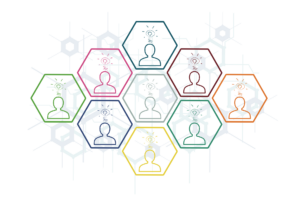Five overall key takeaways from the Strategy & Transformation track detail some of the main innovation themes from the 2024 edition of FEI. All Things Innovation has endeavored to curate the list with a selection of key resources devoted to each topic.
FEI 2024 Strategy & Transformation Track Key Takeaways
1. The Multifaceted Nature of Innovation
Innovation Beyond Products: Innovation beyond product means that while creating new products is a common form of innovation, a company can also innovate in other areas like branding, forging strategic partnerships, developing new services, designing innovative business models, and optimizing internal processes, all contributing to a more holistic approach to driving growth and differentiation in the market.
- Additional Resources: “What is innovation?” from McKinsey & Company.
- “The eight essentials of innovation,” from McKinsey & Company.
- “Product innovation strategies: What businesses need to know,” from Simon Kucher.
- “Ten Types of Innovation,” from Deloitte.
Cross-Functional Collaboration: Cross-functional collaboration means bringing together individuals from different departments within an organization to work jointly on projects, effectively breaking down silos and leveraging diverse expertise to drive innovation and achieve shared goals, rather than operating in isolated units focused solely on their own functions.
- Additional Resources: “Cross-Silo Leadership,” from Harvard Business Review.
- “Making collaboration across functions a reality,” from McKinsey & Company.
- “Cross-Functional Collaboration Overview + Examples,” from Cascade.
- “Overcoming Silos: Promoting Cross-Functional Collaboration for Organizational Effectiveness,” from Forrest Advisors.
Consumer-Centricity: Consumer-centricity means placing the needs, wants, and behaviors of consumers at the heart of a business strategy, ensuring that any innovations or products developed are specifically tailored to resonate with the target audience by deeply understanding their preferences and pain points; essentially, putting the consumer first in every decision-making process.
- Additional Resources: “3 Practical Steps to Execute a Customer-Centric Marketing Strategy,” from Gartner.
- “6 Ways to Build a Customer-Centric Culture,” from Harvard Business Review.
- “3 Common Barriers to Customer Centricity,” from HubSpot.
- “Customer Centricity: The Definitive Guide,” from Alida.
2. The Transformative Role of AI and Technology
AI as an Enabler: AI and emerging technologies like big data and predictive analytics can significantly enhance the innovation process by streamlining research, generating ideas, and accelerating decision-making.
- Additional Resources: “How AI Is Accelerating Innovation In Research And Development,” from Forbes.
- “Fueling the AI transformation: Four key actions powering widespread value from AI, right now,” from Deloitte.
- “Digital twins and generative AI: A powerful pairing,” from McKinsey & Company.
- “The new Essential Eight technologies: what you need to know,” from PWC.
The Human-AI Dance: The most impactful innovations arise from the synergistic collaboration between human creativity and AI capabilities.
- Additional Resources: “Collaborative Intelligence: Humans and AI Are Joining Forces,” from Harvard Business Review.
- “Human or AI?: The Edge on Innovation,” from Korn Ferry.
- “The Ultimate Guide to Navigate the Future of Innovation,” from Itonics.
- “The organization of the future: Enabled by gen AI, driven by people,” from McKinsey & Company.
Democratizing Discovery: AI-powered tools can empower teams across the organization to conduct independent research and contribute to the innovation pipeline.
- Additional Resources: “Empowering Innovation Through the Democratization of AI,” from All Things Innovation.
- “How AI Takes ‘Democratized’ Innovation To The Next Level,” from Forbes.
- “Democratizing Innovation,” from MIT Press.
- “Democratizing innovation: Stop failure, start success,” from USA Today.
3. Navigating Challenges and Embracing Change
Balancing Today and Tomorrow: Organizations must manage the tension between current operational demands and future-focused innovation efforts.
- Additional Resources: “Balancing Short-Term And Long-Term Innovation Goals,” from All Things Innovation.
- “Balancing the Future Against Today’s Needs,” from Harvard Business School.
- “A New Era of Competition Calls for Co-Ambidexterity,” from BCG.
- “Building Ambidexterity Into an Organization,” from MIT Sloan Management Review.
Flexibility and Resilience: The innovation journey is not always linear; organizations need to be adaptable, resilient, and celebrate incremental progress.
- Additional Resources: “McKinsey on Risk & Resilience,” from McKinsey & Company.
- “Resilience and adaptability are key to navigating today’s world,” from World Economic Forum.
- “Product and Process Flexibility in an Innovative Environment,” from Stanford Business.
- “Embracing Agility and Flexibility for Business Resilience,” from Brookey & Company.
Cultivating Influence: Building coalitions, securing buy-in from leadership, and engaging key influencers are crucial for driving enterprise-wide innovation.
- Additional Resources: “Creating High-Impact Coalitions,” from Harvard Business Review.
- “How can you build a coalition of supporters to influence senior leaders?” from LinkedIn.
- “A Better Way to Unlock Innovation and Drive Change,” from MIT Sloan Management Review.
- “The Leadership of Innovation,” from Berkeley.
Self-Disruption: Embracing discomfort, taking calculated risks, and continuously challenging the status quo are essential for personal and organizational growth.
- Additional Resources: “Sustaining the Self-Disruption Journey,” from All Things Innovation.
- “Courage under fire: Embracing disruption,” from Deloitte.
- “Disrupt Yourself,” from Harvard Business Review.
- “The seven principles of self-disruption that any established brand needs,” from LinkedIn.
4. Strategic Approaches to Innovation
Systems Design: A structured process that integrates AI and human efforts is essential for achieving predictable and efficient innovation outcomes.
- Additional Resources: “How AI revolutionizes innovation management,” from ScienceDirect.
- “What is Systems Design? How to Surface Opportunities for Change,” from IDEO.
- “Humans in the Loop: The Design of Interactive AI Systems,” from Stanford University.
- “Smarter together: Why artificial intelligence needs human-centered design,” from Deloitte.
Agile Research: AI-enabled anthropology can accelerate agile research and insights by providing deeper, human-centric understanding at scale and speed.
- Additional Resources: “Applying AI to Anthropological Research,” from All Things Innovation.
- “Three tips for using AI-powered insights for innovation,” from Kantar.
- “Embracing Agile,” from Harvard Business Review.
- “AI Meets Agile: Transforming Project Management For The Future,” from Forbes.
Leveraging Data: Utilizing internal and external data sources can inform decision-making, uncover opportunities, and drive innovation strategies.
- Additional Resources: “Harnessing the power of external data,” from McKinsey & Company.
- “What’s Your Data Strategy?” from Harvard Business Review.
- “Data-Driven Decision Making: A Primer for Beginners,” from Northeastern University.
- “When consumer data drives, retailers and brands win,” from EY.
Acquisition for Disruption: Strategic acquisitions can provide access to new capabilities, technologies, and talent, enabling organizations to achieve disruptive innovation.
- Additional Resources: “Disruptive M&A: Assessing the Risks and Rewards,” from The Wall Street Journal.
- “Expanding M&A Options for New Capabilities,” from Bain & Company.
- “Disruptive M&A: Creating value through innovation-led acquisitions,” from Deloitte.
- “How to win in the age of the complex deal,” from KPMG.
5. Fostering a Culture of Innovation
Leadership and Mindset: A culture of innovation requires leadership support, a willingness to embrace change, and a growth mindset among employees.
- Additional Resources: “New leadership for a new era of thriving organizations,” from McKinsey & Company.
- “Top 5 Leadership Trends That Will Shape 2025,” from Korn Ferry.
- “An Innovation Culture That Gets Results,” from BCG.
- “A Better Way to Unlock Innovation and Drive Change,” from MIT Sloan Management Review.
Purposeful Growth: Defining clear goals and metrics for innovation ensures that efforts are aligned with the organization’s overall strategy.
- Additional Resources: “The Eight Essentials of innovation performance,” from McKinsey & Company.
- “How to Define Clear Innovation Objectives and Goals,” from Itonics.
- “How Leaders Can Create a Purpose-Driven Culture,” Harvard Business Review.
- “The Future of Strategic Measurement: Enhancing KPIs With AI,” from MIT Sloan Management Review.
Continuous Learning: Embracing a learning mindset, experimenting with new approaches, and iterating based on feedback are crucial for sustained innovation.
- Additional Resources: “Building a Culture of Experimentation,” from Harvard Business Review.
- “How To Foster A Culture Of Continuous Learning,” from Forbes.
- “Three Steps to Building a Learning Culture That Delivers Innovation,” from MIT Sloan Management Review.
- “Creating a Culture of Experimentation,” from All Things Innovation.
Click the following links to dive into each FEI 2024 Strategy & Transformation session:
- Business Transformation: Design Thinking, Change Management and Cultural Evolution To Drive Growth: Christian Saclier, VP Design Innovation, Pepsico
- Agile Insights Unleashed: AI and Anthropology Transform Buzz into Reality: Cheryl Auger, Senior Director of Research, Lux Research
- Implementing An AI-Driven Innovation Discovery Process: Miranda Helmer, Vice President, Innovation Discovery & Oksana Sobol, Sn. Dir, Insights Lead, The Clorox Co.
- From Innovation Strategy to Enterprise Transformation: Ophelia Chiu, Vice President, Strategic Innovation, Memorial Sloan Kettering
- Igniting Innovation: Harnessing the Power of Consumer Insights: Laima Widmer, VP, Market Research, Suzy and Alex Forman, Manager, Consumer Insights, Keurig Dr Pepper
- Self-Disruption: Balancing Short Term Gain with Long Term Meaningful Value: Mark Slavens, President and Chief Operating Officer, Nano-Yield
- Innovating Beyond Products: Strategies for Creating Value Through Business Model Innovation: Gus Valen, Chief Executive Officer & Entrepreneur, The Valen Group
Contributor
-

Matthew Kramer is the Digital Editor for All Things Insights & All Things Innovation. He has over 20 years of experience working in publishing and media companies, on a variety of business-to-business publications, websites and trade shows.
View all posts



















































































































































































































